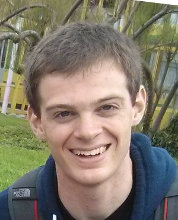Variational inference in 5 minutes
Variational inference has a reputation of being really complicated or involving mathematical black magic. I think part of this is because the standard derivation uses Jensen’s inequality in a way that seems unintuitive. Here’s an derivation that feels easier to me, using only the notion of KL divergence between probability distributions.
Let $p(x,z)$ be a probability model with observed variables $x$ and latent variables $z$.1 We want to infer the posterior $p(z|x)$, but in general this won’t have any nice form that we can write down. Instead, we’ll pick some approximating family $q(z;\lambda)$, with parameters $\lambda$, and then try to find the distribution within this family that best approximates the posterior. For example, if we model each latent variable independently (a “mean field” approximation) using a scalar Gaussian, the parameters $\lambda$ are just the means and standard deviations of these Gaussians.

A variational Gaussian approximation to a scalar posterior.
A natural approach to fitting the approximation parameters $\lambda$ is to minimize the KL divergence between our approximation $q(z;\lambda)$ and the posterior $p(z|x)$.2 Writing this out,
\begin{align} KL\left[q(z;\lambda) \| p(z|x)\right] &= \int q(z;\lambda) \log \frac{q(z;\lambda)}{p(z|x)} dz,\end{align}
we see that it depends on the posterior density $p(z|x)$ which we don’t know. However, we do have access to the joint distribution $p(x, z)$, which is proportional to the posterior, so we can just apply simple algebra to unpack the normalizing constant:
\begin{align} KL\left[q(z;\lambda) \| p(z|x)\right] &= \int q(z;\lambda) \log \frac{q(z;\lambda)}{p(z|x)} dz\\&= \int q(z;\lambda) \left[\log q(z;\lambda) - \log p(z|x)\right] dz\\&= \int q(z;\lambda) \left[\log q(z;\lambda) - \log \frac{p(x,z)}{p(x)}\right] dz\\&= \log p(x) + \int q(z;\lambda) \left[\log q(z;\lambda) - \log p(x,z) \right] dz\\&= \log p(x) - \mathcal{F}(\lambda; x).\end{align}
This shows that the KL divergence is equal to the model evidence $\log p(x)$, which is an (unknown) normalizing constant, minus a term $\mathcal{F}$ given by
\[\mathcal{F}(\lambda; x) = \int q(z;\lambda) \left[ \log p(x,z) - \log q(z;\lambda)\right] dz.\] This term is alternately referred to as (negative) variational free energy or the evidence lower bound (ELBO). It is a lower bound on $\log p(x)$ because we can write $\log p(x) = \mathcal{F} + KL\left[q(z;\lambda)\|p(z|x)\right]$ and the KL divergence is nonnegative. Since the model evidence is constant, maximizing $\mathcal{F}$ minimizes the KL divergence.
This is the core of variational inference: pick an approximating family and minimize KL divergence between your approximation and the true posterior. If you just do this, you will naturally derive the variational bound $\mathcal{F}$ without any algebraic tricks or appeals to Jensen’s inequality.
The practical difficulty tends to be that $\mathcal{F}$ involves an expectation, so evaluating and optimizing it requires either model-specific math3 or Monte Carlo techniques. In the next post I’ll describe the simple Monte Carlo method used by Stan (among others) to perform variational inference in any model where gradients are available.
-
For example, $z$ might be the weights in a Bayesian neural net or logistic regression, and $x$ the observed outputs. ↩
-
There are other approaches, including the alternate divergence
$KL[p\|q]$which leads to expectation propagation, or the Laplace approximation which locally matches the curvature at the mode. ↩ -
For certain classes of models, e.g., exponential families with conjugate priors, the math is well understood and essentially automateable. This is the idea behind variational message passing as implemented in, e.g., Infer.NET. ↩
